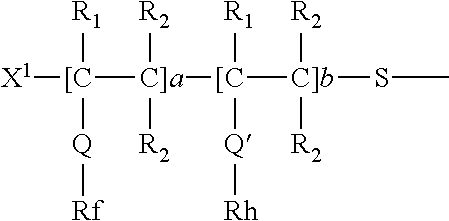Composition and method for providing stain release or stain repellency to substrates
a technology of stain repellency and substrate, applied in the field of compounding and providing, can solve the problems affecting the appearance of the original tile, so as to achieve the effect of increasing the porosity of the substrate and easy penetration into the substra
- Summary
- Abstract
- Description
- Claims
- Application Information
AI Technical Summary
Benefits of technology
Problems solved by technology
Method used
Image
Examples
examples
[0082]The following examples further illustrate the invention without the intention however to limit the invention thereto. All parts are by weight unless indicated otherwise.
Abbreviations
[0083]
AbbreviationsProductAvailabilityFC-1PM 5000, Low Molecular3Mweight FC acrylate aqueousdispersion at 30% solidsFC-2L20358 FC urethane3Moligomer aqueous dispersionat 30% solidsACRYL-1Acronal ™ S 559BASFStyrene-acrylate dispersionACRYL-2Acronal ™ S 790BASFStyrene-acrylate dispersionSIL-1Betolin ™ Li22WoellnerLi-silicate solutionSIL-2Betolin ™ Li24WoellnerLi-silicate solutionSIL-3Betolin ™ P35WoellnerK-silicate solutionSIL-4Betolin ™ P50WoellnerK-silicate solutionSIL-5PQ ™ K(2,15)34 / 36 FPQ EuropeK-silicate solutionSIL-6PQ ™ K(2,5) 26 / 29 FPQ EuropeK-silicate solution
Methods of Application and Testing
[0084]Treatment mixtures were applied to 10×10 cm test samples of grey concrete tiles, available from Coeck, Belgium by brush application until saturation. Excess treatment mixture was removed after 15...
examples 1 to 5
and Reference Examples Ref 1 to Ref 10
[0097]In examples 1 to 5, blends were made containing 3% of FC-1, 5% silicate and 5% acrylic resin as given in table 2. Reference examples Ref 1 to Ref 5 were made without FC-1 and reference examples Ref 5 to Ref 10 were made without use of acrylic resin. The treatment mixtures were brush applied according to the general procedure onto grey concrete tiles, available from Coeck, Belgium The treated samples were conditioned at room temperature during 1 week and were then tested for stain repellency, OR and WR. The results are given in table 3.
TABLE 2composition of examplesExFCSilicateStyrene acrylate13% FC-15% SIL-15% ACRYL-123% FC-15% SIL-25% ACRYL-133% FC-15% SIL-35% ACRYL-143% FC-15% SIL-45% ACRYL-153% FC-15% SIL-55% ACRYL-1Ref 13% FC-15% SIL-1 / Ref 23% FC-15% SIL-2 / Ref 33% FC-15% SIL-3 / Ref 43% FC-15% SIL-4 / Ref 53% FC-15% SIL-5 / Ref 6 / 5% SIL-15% ACRYL-1Ref 7 / 5% SIL-25% ACRYL-1Ref 8 / 5% SIL-35% ACRYL-1Ref 9 / 5% SIL-45% ACRYL-1 Ref 10 / 5% SIL-55% ACRY...
examples 6 to 15
and Reference Examples Ref 11 to Ref 15
[0098]Examples 6 to 15 were made with blends made of 3% FC-2 with 5% silicate and 5% acrylic resins as given in table 4. Reference examples Ref 11 to Ref 15 were made without the use of acrylic resin. The treatment mixtures were brush applied according to the general procedure onto grey concrete tiles, available from Coeck, Belgium. The treated samples were conditioned at room temperature during 1 week and were then tested for stain repellency. The results are presented in table 5.
TABLE 4composition of examplesExFCSilicateStyrene acrylate63% FC-25% SIL-15% ACRYL-173% FC-25% SIL-25% ACRYL-183% FC-25% SIL-35% ACRYL-193% FC-25% SIL-45% ACRYL-1103% FC-25% SIL-55% ACRYL-1113% FC-25% SIL-15% ACRYL-2123% FC-25% SIL-25% ACRYL-2133% FC-25% SIL-35% ACRYL-2143% FC-25% SIL-45% ACRYL-2153% FC-25% SIL-55% ACRYL-2Ref 113% FC-25% SIL-1 / Ref 123% FC-25% SIL-2 / Ref 133% FC-25% SIL-3 / Ref 143% FC-25% SIL-4 / Ref 153% FC-25% SIL-5 /
TABLE 5Repellency propertiesExOlive oi...
PUM
| Property | Measurement | Unit |
|---|---|---|
| Percent by mass | aaaaa | aaaaa |
| Percent by mass | aaaaa | aaaaa |
| Percent by mass | aaaaa | aaaaa |
Abstract
Description
Claims
Application Information
 Login to View More
Login to View More - R&D
- Intellectual Property
- Life Sciences
- Materials
- Tech Scout
- Unparalleled Data Quality
- Higher Quality Content
- 60% Fewer Hallucinations
Browse by: Latest US Patents, China's latest patents, Technical Efficacy Thesaurus, Application Domain, Technology Topic, Popular Technical Reports.
© 2025 PatSnap. All rights reserved.Legal|Privacy policy|Modern Slavery Act Transparency Statement|Sitemap|About US| Contact US: help@patsnap.com


